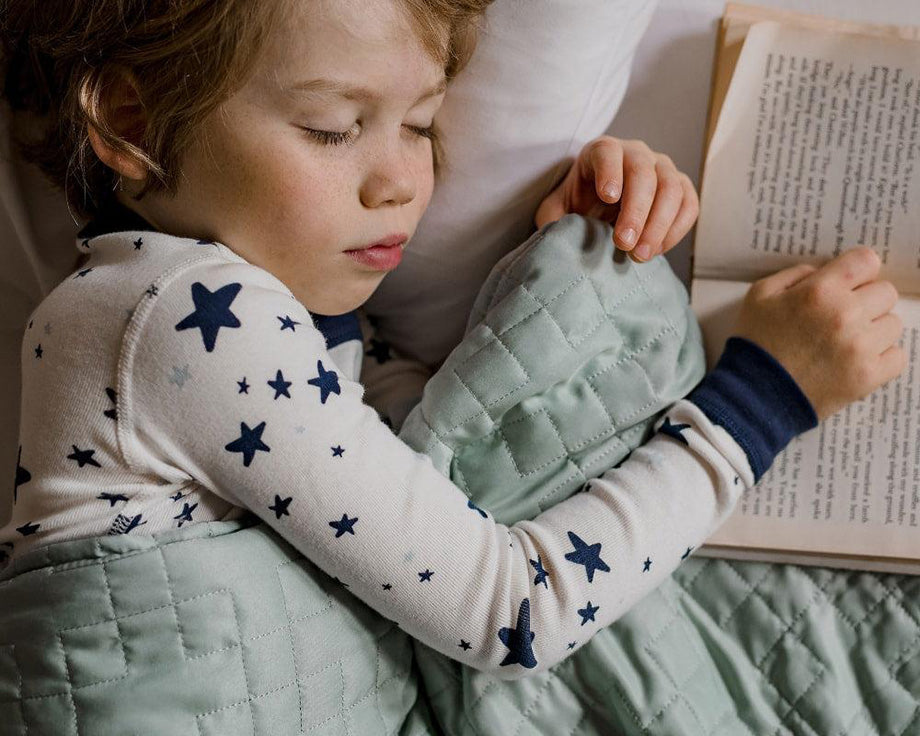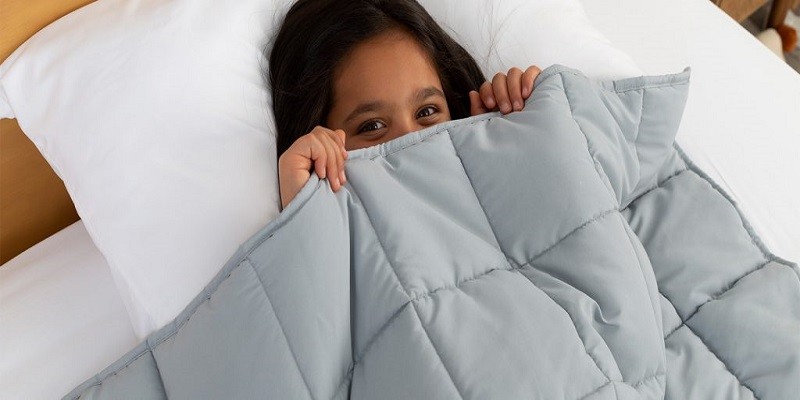A weighted blanket for a child should be 10% of their body weight to ensure effectiveness and safety. A weighted blanket can be a beneficial tool for children, providing comfort and calming effects.
However, it is essential to choose the right weight to maximize its benefits. A general guideline is that a weighted blanket should be around 10% of a child’s body weight. For example, if a child weighs 50 pounds, the ideal weight for their weighted blanket would be 5 pounds.
This weight helps provide the necessary pressure without being too overwhelming or restricting. It is crucial to consider the individual needs and preferences of the child when determining the appropriate weight for their weighted blanket.
Factors To Consider When Determining The Weight Of A Weighted Blanket
Determining the weight of a weighted blanket for a child involves considering several factors. These include the child’s weight, age, sensory needs, and preferences, ensuring a comfortable and safe sleep experience.
Weighted blankets have gained popularity due to their potential to promote relaxation and improve sleep quality in individuals, including children. However, finding the right weight for a child’s weighted blanket can be a crucial task. The weight of the blanket should be carefully determined, taking into account various factors that contribute to the child’s comfort and safety. In this section, we explore two essential factors to consider when determining the weight of a weighted blanket for a child: the age and weight of the child, and their sensory needs and preferences.
Age And Weight Of The Child
The age and weight of the child play a significant role in determining the appropriate weight of a weighted blanket. Different age groups and body weights require different levels of pressure for optimal comfort and safety. Here’s a breakdown of the recommended blanket weight based on age and weight:
- For toddlers and preschoolers weighing between 20 to 40 pounds, a blanket weighing around 3 to 6 pounds is typically suitable.
- For children aged 5 to 12 years, weighing between 50 to 100 pounds, a blanket weighing approximately 7 to 12 pounds generally works well.
- For teenagers and older children weighing over 100 pounds, a blanket weighing between 10 to 20 pounds may provide the desired therapeutic benefits.
The weight guidelines provided above are just a starting point. It’s essential to consider other factors, such as sensory needs and preferences, to determine the most suitable weight for your child’s weighted blanket.
Sensory Needs And Preferences
Every child is unique and has different sensory needs and preferences. Some children may enjoy deep pressure and find heavier blankets more soothing, while others may prefer lighter weights. It’s crucial to consider your child’s sensory preferences when selecting a weighted blanket.
If your child has sensory processing difficulties or seeks deep pressure for comfort, you might consider choosing a slightly heavier blanket within the weight range mentioned earlier. This can help provide a calming effect and promote better sleep.
On the other hand, if your child is sensitive to touch and prefers gentler pressure, opting for a lighter weighted blanket may be more appropriate. A blanket on the lower end of the suggested weight range can still provide the benefits of deep pressure without overwhelming sensory sensitivities.
Ultimately, it’s crucial to pay attention to your child’s cues and preferences. Comfort and safety should be the primary factors to consider when deciding on the weight of a weighted blanket for your child.
Determining the weight of a weighted blanket for a child involves considering their age, weight, sensory needs, and preferences. By carefully assessing these factors, you can help ensure that the weighted blanket provides the right amount of pressure to promote relaxation, comfort, and a restful sleep for your child.
Recommended Weight Range For Weighted Blankets For Children
Children benefit from weighted blankets within a recommended weight range. Find out how heavy a weighted blanket should be for a child to provide optimum comfort and calming effects.
Choosing the right weighted blanket for your child can make a world of difference in their sleep quality and overall well-being. When it comes to determining the appropriate weight range for a weighted blanket, it’s crucial to consider your child’s weight and size. In this section, we will explore the guidelines for weighted blankets based on a child’s weight and how to calculate the suitable weight range using the 10% rule.
Guidelines For Weighted Blankets Based On Child’s Weight
Weighted blankets are designed to provide gentle pressure and deep touch stimulation, which can have a calming and comforting effect on children. The weight of the blanket should be carefully chosen to ensure it is not too heavy or too light for the child. Here are some general guidelines based on a child’s weight:
| Child’s Weight Range | Recommended Blanket Weight |
|---|---|
| 30-50 lbs | 5-7 lbs |
| 50-70 lbs | 7-10 lbs |
| 70-90 lbs | 10-12 lbs |
| 90+ lbs | 12+ lbs |
Remember, these are general guidelines and each child is unique. It’s essential to take into account your child’s specific needs and preferences when choosing the weight of their blanket.
Applying The 10% Rule: Calculating The Appropriate Weight Range
The 10% rule is a popular method used to calculate the suitable weight range for a weighted blanket. It suggests that the blanket should weigh approximately 10% of the child’s body weight. Here’s how you can apply the 10% rule:
- Weigh your child accurately using a scale
- Multiply your child’s weight by 10% (e.g., if your child weighs 60 lbs, multiply 60 by 0.10)
- The result will give you the recommended weight range for the blanket (e.g., 6 lbs)
It’s important to note that the 10% rule is a starting point and not a definitive rule. Some children may prefer a slightly heavier or lighter blanket, depending on their personal comfort.
Ultimately, selecting the right weighted blanket weight for your child involves careful consideration and trial and error. Listening to your child’s feedback and observing their sleep patterns can help you determine if the current weight is suitable or if adjustments need to be made.
By following these guidelines and understanding the 10% rule, you can find the ideal weighted blanket weight that promotes a peaceful and restful sleep for your child.
Adjusting The Weighted Blanket For Optimal Comfort And Effectiveness
When it comes to selecting a weighted blanket for your child, the right amount of weight is crucial. But determining how heavy a weighted blanket should be for a child can be a bit challenging. In this section, we will explore the factors to consider when adjusting the weighted blanket for optimal comfort and effectiveness.
Ensuring Proper Weight Distribution
Proper weight distribution is essential for the overall effectiveness of the weighted blanket and ensuring your child’s comfort. To achieve this, it is advisable to choose a blanket that covers the entire body evenly. By evenly distributing the weight, your child will experience the calming and relaxing benefits of the blanket.
In addition to the blanket’s overall weight, the size of the blanket also matters. Most experts recommend that the weighted blanket should be around 10% of your child’s body weight. For instance, if your child weighs 50 pounds, a 5-pound weighted blanket would be suitable. It is essential to ensure you follow this guideline to prevent the blanket from being too heavy or too light, which can hinder its effectiveness.
Consulting With Occupational Therapists Or Medical Professionals
If you are uncertain about the appropriate weight for your child’s weighted blanket, it is always a good idea to consult with occupational therapists or medical professionals. They can provide expert guidance based on your child’s specific needs, sensory preferences, and any underlying conditions.
An occupational therapist can conduct a thorough assessment to determine the optimal weight for your child’s weighted blanket. They will consider various factors like your child’s age, weight, developmental stage, and sensory processing needs. By consulting with a professional, you can ensure that the weighted blanket is tailored to your child’s requirements, maximizing its benefits.
Remember, each child is unique, and what works for one may not work for another. Seeking professional advice can help you make informed decisions regarding the weight and other specifications of the weighted blanket, ensuring that your child receives the most effective sensory input and comfort.

Credit: gravityblankets.com
Frequently Asked Questions On How Heavy Should A Weighted Blanket Be For A Child?
How Heavy Should A Weighted Blanket Be For A Child?
A weighted blanket for a child should be approximately 10% of their body weight to be effective and safe.
What Are The Benefits Of Using A Weighted Blanket For A Child?
Using a weighted blanket can help a child with sensory processing issues, anxiety, and promote better sleep quality.
Can A Weighted Blanket Be Too Heavy For A Child?
Yes, a weighted blanket can be too heavy for a child and may cause discomfort or potential safety concerns.
At What Age Can A Child Start Using A Weighted Blanket?
Children can start using a weighted blanket around the age of two, but it’s important to consult with a pediatrician or occupational therapist.
How Long Should A Child Use A Weighted Blanket Each Day?
A child can use a weighted blanket for around 20-30 minutes per session, gradually increasing the duration if they find it helpful.
Are There Any Risks Or Side Effects Of Using A Weighted Blanket For Children?
While generally safe, some children may find weighted blankets too restrictive or experience increased body temperature. Monitoring is advised.
Conclusion
Ultimately, finding the right weight for a child’s weighted blanket is crucial for its effectiveness and safety. As a general guideline, the blanket should be around 10% of the child’s body weight. However, it is important to consider their comfort level and individual needs.
Remember to consult with a healthcare professional or occupational therapist to determine the ideal weight for your child. By providing them with an appropriately weighted blanket, you can help promote better sleep and relaxation.
Last Updated on January 15, 2025 by Marjorie R. Rogers, MA (English), Certified Consultant

